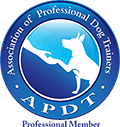Archive CF :: Home Alone
In the wild, a lone dog has little chance of survival. It is in increased danger from other predators; it has little chance of success at the hunt. It's a wonder that a species as dependent on the pack as the dog can adapt to being alone at all!
It has been observed in wild dogs that the mother dog will periodically move from one den to another. She will move the pups one at a time, choosing a different one each time to be left alone in the new den or in the previous den. In so doing, she is teaching her pups to have a tolerance to being alone.
Good breeders do the same thing, leaving puppies alone for short periods of time after their eyes have opened and they can respond to sounds. This way the pups will learn that they will be alone only for a short period before their human or canine parent returns. Without this early learning, a puppy can become too dependent on the presence of others.
Separation Anxiety
Separation anxiety is a serious emotional state in which a dog becomes anxious and panicked when his owner is absent. The physical manifestations of it have been compared to a panic attack in humans.
Typical symptoms are vocalization, destructive behavior or self-mutilation, physical manifestations (panting, drooling, sweaty paw pads, dilated pupils, trembling), breaking of housetraining, and anorexic behavior. The anxiety begins to build during the owner's departure ritual and the symptoms occur within the first minutes after departure.
Shelter dogs are at an increased risk for developing separation anxiety. They have had bonded relationships with humans in the past which have been severed and so they may likely bond more strongly in subsequent human relationships. In addition, it may have been the animal's separation anxiety that brought about her surrender to the shelter in the first place. While any dog can conceivably develop separation anxiety, it occurs more frequently with dogs who are particularly affiliative toward humans -- "soft", bondy dogs.
Hyper-Attachment
Dog fanciers and trainers alike are guilty of over-diagnosing separation anxiety in dogs who express separation sensitivity. Separation anxiety is a clinical term that should be strictly reserved for the serious state of panic.
Instead, I like to use the term hyper-attachment to label a constellation of behaviors typified by: constant following in the home, exaggerated excitement upon return after even a short absence, heightened anxiety when separated from the human family in environments away from home, anxious behavior when the dog is positioned so she can able watch departure from the home, etc.
Often such dogs are perfectly fine when their lives are routinized but they get overly anxious with change. So, should there be a need to vary your dog's routine, such as leaving her at another family member's house on occasion, steps should be taken to increase her comfort in this new context. Separation anxiety treatment protocols can be employed to build tolerance to aloneness in different situations.
Be aware that hyper-attachment, left unresolved, can develop into the more serious condition of separation anxiety.
Building Separation
From day one with your dog, it's crucial that you continue her education in tolerating aloneness: Do not spend every waking moment with her, as much as you might want to. Here are some ideas for how best to build your pup's tolerance to separation:
- Leave your dog in her crate or confinement area with a Kong stuffed with something yummy, like peanut butter or liverwurst. Start with short absences, just a few seconds. Gradually increase the duration of your absences, making sure that your dog is still happily working away on her toy. Keep everything low-key, drifting in and out of the room.
- When you return, pick up her toy. The yummy treats are hers only when you are not present. Pretty soon she'll be looking forward to your absence!
- Remember to randomize the duration of your absences, sometimes being away a little longer, sometimes a little shorter. You don't want your pup to think that you'll always be gone for long stretches. Sometimes it's only a few seconds, right? Nothing to get upset about!
- If your dog begins to get at all anxious, protesting from the crate, you may have increased the duration too quickly or the session may have been too long. Quit long before she's had enough.
- Practice low-key departures and arrivals. Emotional histrionics only serve to emotionally charge your comings and goings. When you take a trip out to the kitchen, do you bid a fond, emotional farewell to your dog? Probably not. So make the same sort of departures when you leave home.
- Soft classical music can help as it is soothing and it can drown out the environmental cues of your presence and absence. However, it should not simply be turned on just before departure and turned off just after arrival or it will become another aloneness indicator.
- Exercise is a great way to prepare your dog for time alone. A dog whose energy has been spent on a nice, brisk run will be more ready to settle down quietly for a little rest. So, before beginning exercises in enforced aloneness, exercise your dog to take the edge off his energy level.
Treating Separation Anxiety
- For your dog, certain triggers may become associated with your departure. Putting your shoes and coat on, grabbing your purse or briefcase, jingling your keys may all be indicative of departure to your dog -- even their ordering may become a chain of events that the dog recognizes. Work on decoupling these triggers by performing them randomly without their resulting in departure. So, for example, jingle your keys, then drop them back on the table, while you're watching TV. Fiddle with the front door lock, even open the front door, then simply close and lock it again. Who says the door opening means you're leaving?! This is called desensitizing the triggers.
- Now try to teach your dog to feel differently about the triggers. Give her a Kong stuffed with something yummy, and perform the trigger (like jingling the keys or opening the front door). Then, promptly take the Kong away. You are counter-conditioning your dog, changing the way she feels about those triggers. Little by little, over the next days and weeks, increase the intensity of the triggers, like jingling the keys and opening the door, etc.
- During the treatment phase, your dog should not be left alone. This is because you are working on lower intensity, below threshold sessions of aloneness. Exposing your dog to the full-blown 8-hour workday will be more than she can handle and will set back all the work you've done thus far. Find a pet sitter, a doggie day care, a friend, maybe take her to work, whatever it takes. It will be worth the effort in the long run.
- Some dogs benefit from knowing that you have left, indicated by an exit cue such as "Be back soon!", while others are more comfortable without clearly knowing whether you're gone from home or just in another room. I would first attempt the latter strategy, graying the presence and absence of the family, before opting for the "Be back soon!" strategy.
- Separation anxiety dogs often don't tolerate crating well. It's likely that they've been crated in the past and had bad experiences, compounding their anxiety. In their frantic attempts to escape, they run the risk of injuring themselves. Some dogs will bite and dig at the crate until their gums and paws bleed. You may have to investigate alternative forms of containment, like a puppy-proofed room, for your aloneness exercises.
The Use of Medication in Treating Separation Anxiety
For dogs who are extremely anxious, it may be necessary to get a prescription for an anti-anxiety medication such as Clomicalm from your vet. When used in tandem with behavior modification protocols, it can take the edge off the anxiety enough to allow the dog to actually accept the positive experiences she's having during the treatment. Often the dog can be weaned off the medication after treatment is successful.
Owner-Absent Misbehaviors
Owner-absent misbehaviors like barking or destruction are frequently attributed to separation anxiety, when it is really just that the dog isn't getting enough exercise or hasn't been properly educated in acceptable alternative outlets for normal dog behavior. It is important to accurately diagnose your dog's problem before commencing treatment.




